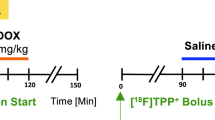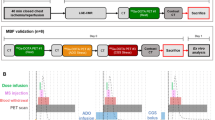Abstract
Background
BMS747158 labeled with 18F is being developed for PET myocardial perfusion imaging. Imaging studies showed clear detection of necrotic tissue in acute myocardial infarcted (MI) animals and a good safety profile in normal animals. This study evaluated BMS747158 imaging and cardiovascular safety in a rabbit model of chronic MI with cardiac compromise.
Methods and Results
Chronic MI rabbits were developed by the left coronary artery ligation followed by 4 weeks recovery. Cardiac PET imaging with BMS747158 (~1.5 mCi, iv) in control rabbits showed clear and uniform myocardial uptake. However, imaging in chronic MI rabbits demonstrated obvious defect area in the left ventricular wall. Before BMS747158 injection, baseline electrocardiogram (ECG) waveforms in lead II configuration were normal with positive QRS complexes in control rabbits. In contrast, MI rabbits exhibited negative QRS complexes with enlarged Q waves and inverted T waves. Baseline values of mean intra-arterial pressure (AP, 61 ± 6 vs 89 ± 11 mmHg), systolic AP (79 ± 11 vs 114 ± 11 mmHg) and diastolic AP (53 ± 4 vs 76 ± 10 mmHg) were lower in MI than in control rabbits. Heart rate (162 ± 36 vs 159 ± 8 beat/minute) and QTc interval (corrected by Fridericia method, 288 ± 17 vs 319 ± 17 ms) were comparable. BMS747158 administration induced no changes from baseline in any of the measured cardiovascular parameters and ECG waveforms in either control or MI rabbits.
Conclusions
Cardiac imaging with BMS747158 allows clear detection of chronic MI without producing any cardiovascular alterations in cardiac compromised rabbits.





Similar content being viewed by others
References
Yu M, Guaraldi MT, Mistry M, Kagan M, McDonald JL, Drew K, et al. BMS-747158-02: A novel PET myocardial perfusion imaging agent. J Nucl Cardiol 2007;14:789-98.
Beller GA, Bergmann SR. Myocardial perfusion imaging agents: SPECT and PET. J Nucl Cardiol 2004;11:71-86.
Nekolla SG, Reder S, Saraste A, Higuchi T, Dzewas G, Preissel A, et al. Evaluation of the novel myocardial perfusion positron-emission tomography tracer 18F-BMS-747158-02: Comparison to 13N-ammonia and validation with microspheres in a pig model. Circulation 2009;119:2333-42.
Maddahi J, Schiepers C, Czernin J, Huang H, Schelbert H, Wijatyk A, et al. First human study of BMS747158, a novel F-18 labeled tracer for myocardial perfusion imaging. J Nucl Med 2008;49:70.
Sherif HM, Saraste A, Weidl E, Weber AW, Higuchi T, Reder S, et al. Evaluation of a novel (18)F-labeled positron-emission tomography perfusion tracer for the assessment of myocardial infarct size in rats. Circ Cardiovasc Imaging 2009;2:77-84.
Abbate A, Biondi-Zoccai GG, Van Tassell BW, Baldi A. Cellular preservation therapy in acute myocardial infarction. Am J Physiol Heart Circ Physiol 2009;296:H563-5.
Sun Y, Weber KT. Infarct scar: A dynamic tissue. Cardiovasc Res 2000;46:250-6.
Morales C, Gonzalez GE, Rodriguez M, Bertolasi CA, Gelpi RJ. Histopathologic time course of myocardial infarct in rabbit hearts. Cardiovasc Pathol 2002;11:339-45.
Mistry M, Onthank D, Green J, Cicio S, Casebier D, Robinson S, et al. Toxicological evaluation of BMS-747158, a PET myocardial perfusion imaging agent. The Toxicologist 2008;102:476.
Lazewatsky J, Azure M, Guaraldi M, Kagan M, MacDonald J, Yu M, et al. Dosimetry of BMS747158, a novel 18F labeled tracer for myocardial perfusion imaging, in nonhuman primates at rest. J Nucl Med 2009;49:15.
Hamlin RL, Kijtawornrat A. Use of the rabbit with a failing heart to test for torsadogenicity. Pharmacol Ther 2008;119:179-85.
Fujita M, Morimoto Y, Ishihara M, Shimizu M, Takase B, Maehara T, et al. A new rabbit model of myocardial infarction without endotracheal intubation. J Surg Res 2004;116:124-8.
Purohit A, Radeke H, Azure M, Hanson K, Benetti R, Su F, et al. Synthesis and biological evaluation of pyridazinone analogues as potential cardiac positron emission tomography tracers. J Med Chem 2008;51:2954-70.
Fridericia LS. Die systolendauer im elecktrokardiogramm bei normalen menschen und bei herzkranken. Acta Med Scand 1920;53:469-86.
Bell DR. Special circulations. In: Rhoades R, Bell DR, editors. Medical physiology: Principles for clinical medicine. 3rd ed. Baltimore, MD: Lippincott Williams & Wilkins; 2008. p. 290-304.
Maxwell MP, Hearse DJ, Yellon DM. Species variation in the coronary collateral circulation during regional myocardial ischaemia: A critical determinant of the rate of evolution and extent of myocardial infarction. Cardiovasc Res 1987;21:737-46.
Gallagher AM, Bahnson TD, Yu H, Kim NN, Printz MP. Species variability in angiotensin receptor expression by cultured cardiac fibroblasts and the infarcted heart. Am J Physiol 1998;274:H801-9.
Makino T, Hattori Y, Matsuda N, Onozuka H, Sakuma I, Kitabatake A. Effects of angiotensin-converting enzyme inhibition and angiotensin II type 1 receptor blockade on beta-adrenoceptor signaling in heart failure produced by myocardial Infarction in rabbits: Reversal of altered expression of beta-adrenoceptor kinase and G i alpha. J Pharmacol Exp Ther 2003;304:370-9.
Fujii T, Yamazaki T, Akiyama T, Sano S, Mori H. Extraneuronal enzymatic degradation of myocardial interstitial norepinephrine in the ischemic region. Cardiovasc Res 2004;64:125-31.
Gao DW, Stillson CA, O’Connell JW. Absence of MIBG uptake in the denervated rabbit heart. J Nucl Med 1996;37:106.
Eisenhofer G, Friberg P, Rundqvist B, Quyyumi AA, Lambert G, Kaye DM, et al. Cardiac sympathetic nerve function in congestive heart failure. Circulation 1996;93:1667-76.
Nable JV, Brady W. The evolution of electrocardiographic changes in ST-segment elevation myocardial infarction. Am J Emerg Med 2009;27:734-46.
Ananthasubramaniam K, Chow BJ, Ruddy TD, deKemp R, Davies RA, DaSilva J, et al. Does electrocardiographic Q wave burden predict the extent of scarring or hibernating myocardium as quantified by positron emission tomography? Can J Cardiol 2005;21:51-6.
Gonzalez GE, Palleiro J, Monroy S, Perez S, Rodriguez M, Masucci A, et al. Effects of the early administration of losartan on the functional and morphological aspects of postmyocardial infarction ventricular remodeling in rabbits. Cardiovasc Pathol 2005;14:88-95.
Connelly CM, Vogel WM, Wiegner AW, Osmers EL, Bing OH, Kloner RA, et al. Effects of reperfusion after coronary artery occlusion on post-infarction scar tissue. Circ Res 1985;57:562-77.
Acknowledgements
We thank the Veterinary Science Group for providing excellent animal care. Some of the data were presented orally at the Society of Nuclear Medicine Annual Meeting in 2009.
Author information
Authors and Affiliations
Corresponding author
Rights and permissions
About this article
Cite this article
Yu, M., Bozek, J., Guaraldi, M. et al. Cardiac imaging and safety evaluation of BMS747158, a novel PET myocardial perfusion imaging agent, in chronic myocardial compromised rabbits. J. Nucl. Cardiol. 17, 631–636 (2010). https://doi.org/10.1007/s12350-010-9221-7
Received:
Accepted:
Published:
Issue Date:
DOI: https://doi.org/10.1007/s12350-010-9221-7




